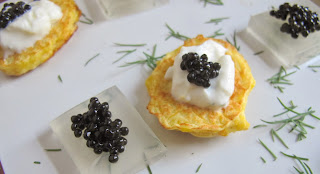We have a tendency to associate Farm-to-Fork with the time when produce is the most abundant - summer and fall harvest. Farm-to-Fork also means eating seasonally, and so, as the weather changes, so do our seasonal ingredients and why certain foods, like pumpkins and cranberries, are associated with the holidays.
For many people caviar is considered a treat for the holiday season. One of those indulgent foods that you only eat around Christmas. It falls among other holiday indulgences such as prime rib, lobster, and cracked crab or less pricey treats such as Christmas cookies, roasted chestnuts, fruit cakes, and marzipan.
Part of the reason we celebrate with caviar during the holidays revolves around the Rule of R. The Rule of R says that shellfish, in particular oysters, should not be eaten in any month without a R. That basically means May, June, July, and August - all warmer months. Although not a shellfish, the Rule of R has also applied to caviar consumption.
The Rule of R was necessary in the past for two reasons. First was due to the easy spoilage of food prior to refrigeration. All seafood is temperature sensitive and any eater that has gotten food poisoning from seafood knows the horrible consequences. For centuries caviar was harvested and consumed almost immediately before the curing process was introduced. Even then, it was essential that the caviar be well chilled up until the time of consumption, a difficult task for much of the world until the advent of refrigeration and ice making.
The second reason is due to the life cycle of a lot of seafood. Many shellfish spawn in the warmer months, making their flesh mushy and less flavorful than shellfish harvested in cooler months. In the case of caviar, the harvesting season revolves around the time when the eggs of the sturgeon are at their ripest. Here in Sacramento, Sterling Caviar harvests the caviar between late January and beginning of June.
Read about the caviar harvesting process.Today caviar goes through a curing process where salt is added and the eggs are allowed to sit in tins for at least three months. Curing not only preserves the caviar, but improves the flavor. The curing process means that the finished caviar is ready for consumption in the fall and perfect for the holidays.
Caviar is no longer just for the wealthy and nobility. In the past caviar’s expense was due to the depletion of worldwide sturgeon stocks. Wild sturgeon don’t reach egg making maturity for 15-20 years. Large breeding age sturgeon were overfished and young sturgeon were killed looking for the eggs before they even had a chance to breed. With fewer sturgeon able to mature and breed, fish populations started to be decimated. The rule of supply and demand says that the less supply, the higher the price.
Now caviar has gone mainstream, especially due to sustainable farming operations such as Sterling Caviar. The sturgeon are kept in giant tanks and are carefully monitored. The sturgeon’s sex is determined early on and the growth cycle of the fish is rapidly increased due to environmental controls. A farmed sturgeon can mature in 7-10 years instead of the 15-20 in the wild. Breeding stock is maintained separately and their eggs are harvested and fertilized in controlled labs to ensure continued generations.
Today you find caviar served at restaurants such as Ella and Enotria as well as for sale at markets like Whole Foods, Corti Brothers, and Taylor's Market. You can also buy it online at SterlingCaviar.com. Order now, in time for Thanksgiving.
If you want to try some caviar appetizers at your holiday event, here are a couple of recipes to try.
Spaghetti Squash Pancakes
The most common serving of caviar is with blinis (small pancakes) and creme fraiche. Another is with latkes (potato pancakes). I decided to do something different with these...
1 cup spaghetti squash strands
1/4 cup flour or gluten free flour
1 egg, beaten
salt and pepper
To get the spaghetti squash strands, cut a small spaghetti squash in half and scrape out the seeds and pulp. Place cut side down on a plate and add 1/4 cup of water to the plate. Tightly cover with plastic wrap. Microwave on high for 10 minutes. Remove and let cool. Once cool, scrape the insides of the squash to release the strands. Place strands into a bowl and using paper towels, squeeze out as much liquid as possible.
In a small bowl, mix together the squash, flour, eggs, and season with a bit of salt and pepper. When thoroughly mixed, drop small dollops onto a hot, oiled skillet, spreading flat to make mini pancakes. Cook for 1-2 minutes until bottoms are browned, flip, and cook second side for an additional minute or until side is golden brown. Remove from heat and let cool.
Cream topping
1 cup of either sour cream or Greek yogurt
zest of one small lemon
1 teaspoon fresh squeezed lemon juice
1 teaspoon fresh dill weed, chopped
Mix together in a small bowl.
Assembly:
Place pancakes on a serving plate. Top with a dollop of the topping. Garnish with a small spoonful of caviar. Remember not to use metal spoons when serving the caviar.
 |
| I added a slice of lobster here |
Aspic and Caviar
This recipe is adapted from Dorie Greenspan's, in her book Around My French Table. I was unable to quickly find fish stock or fish bouillon so I made my own. You can use any seafood debris - lobster, fish heads, shrimp skins - to make your own stock.
2 cups of fish stock
2 packages of gelatin powder, unflavored
Fish stock should be boiling hot. If it is homemade, be sure to strain the stock using a strainer and cheesecloth. Pour in the packages of gelatin and stir until the gelatin is completely dissolved. Pour into a square metal cake pan and refrigerate for a minimum of three hours to set.
Once set, use a sharp knife to cut around the edges. You may have to heat the bottom of the pan with a hot, wet dishtowel to release the bottom. Use a ruler to cut the aspic into one inch cubes. Top with caviar. Serve immediately.
Disclosure: Sterling Caviar supplied me the caviar for these recipes.

.png)



